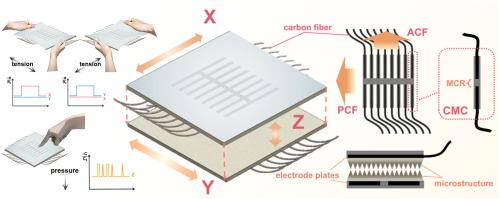Anisotropic composite sensor based on CF/CB for strain and pressure sensing
IF 7.7
2区 材料科学
Q1 MATERIALS SCIENCE, COMPOSITES
引用次数: 0
Abstract
Flexible sensors have made significant progress in wearable devices, however traditional uniaxial sensors still face huge challenges in distinguishing three-dimensional (3D) motions. In this paper, a cost-effective and high-performance composite sensor based on carbon fiber (CF) in conjunction with the modulus cliff region (MCR) is proposed to distinguish strain direction and detect pressure. The composite sensor consists of two identical strain sub-sensors stacked orthogonally, with pressure-sensitive microstructures uniformly distributed between the two layers. The composite sensor exhibits remarkable anisotropic strain sensing performance with gauge factors (GF) of 46.4 and −1.2 corresponding to loads applied along the carbon fiber (ACF) direction and perpendicular carbon fiber (PCF) direction, respectively. Meanwhile, the composite sensor demonstrates an excellent pressure sensing performance with a sensitive capacitance response (S = 0.15 kPa−1), outstanding stability (2000 cycles) and tiny pressure (75 mg) detection capability. In addition, the composite sensor shows application prospects in posture detection, muscle state recognition, and pulse monitoring, which provides new ideas and methods for future smart health devices.

基于CF/CB的应变和压力传感各向异性复合传感器
柔性传感器在可穿戴设备中取得了重大进展,但传统的单轴传感器在识别三维运动方面仍面临巨大挑战。本文提出了一种基于碳纤维(CF)结合模量悬崖区(MCR)的经济高效的复合材料传感器,用于应变方向识别和压力检测。复合传感器由两个相同的应变子传感器正交堆叠而成,压敏微结构均匀分布于两层之间。复合材料传感器表现出良好的各向异性应变传感性能,沿碳纤维(ACF)方向和垂直碳纤维(PCF)方向加载时,测量因子(GF)分别为46.4和−1.2。同时,该复合传感器具有灵敏的电容响应(S = 0.15 kPa−1)、优异的稳定性(2000次循环)和微小压力(75 mg)检测能力,具有优异的压力传感性能。此外,复合传感器在姿势检测、肌肉状态识别、脉搏监测等方面显示出应用前景,为未来的智能健康设备提供了新的思路和方法。
本文章由计算机程序翻译,如有差异,请以英文原文为准。
求助全文
约1分钟内获得全文
求助全文
来源期刊

Composites Communications
Materials Science-Ceramics and Composites
CiteScore
12.10
自引率
10.00%
发文量
340
审稿时长
36 days
期刊介绍:
Composites Communications (Compos. Commun.) is a peer-reviewed journal publishing short communications and letters on the latest advances in composites science and technology. With a rapid review and publication process, its goal is to disseminate new knowledge promptly within the composites community. The journal welcomes manuscripts presenting creative concepts and new findings in design, state-of-the-art approaches in processing, synthesis, characterization, and mechanics modeling. In addition to traditional fiber-/particulate-reinforced engineering composites, it encourages submissions on composites with exceptional physical, mechanical, and fracture properties, as well as those with unique functions and significant application potential. This includes biomimetic and bio-inspired composites for biomedical applications, functional nano-composites for thermal management and energy applications, and composites designed for extreme service environments.
 求助内容:
求助内容: 应助结果提醒方式:
应助结果提醒方式:


